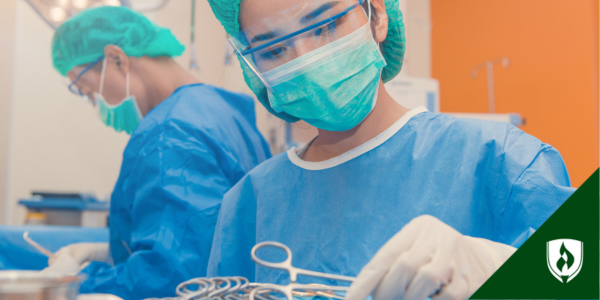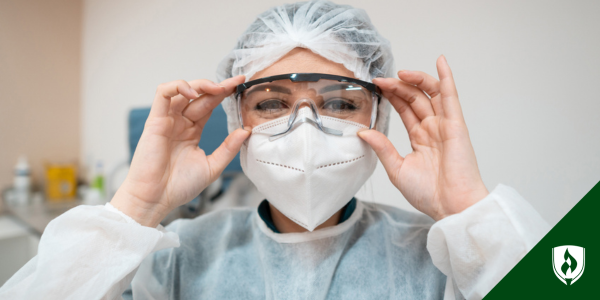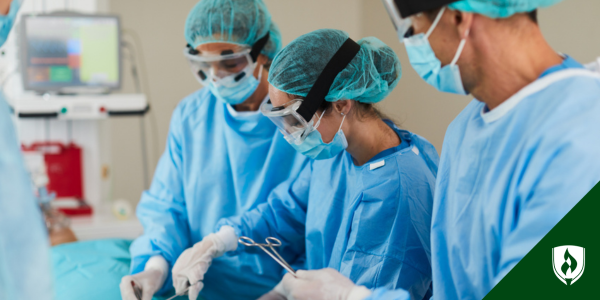
Long hospital stays following a surgical procedure can be grueling for both patients and their families. The impact of sleeping in uncomfortable beds within loud and busy units, navigating visiting hours and hospital parking, increased risk of infection, and a staggeringly high price tag for both hospitals and patients, have helped lead to the rise of another approach: outpatient surgery.
Outpatient surgical procedures, sometimes also called ambulatory surgeries, are any procedures that do not require an overnight hospital stay following the operation. Outpatient procedures are often conducted in a doctor’s office or an ambulatory surgery center, but can also be performed in an outpatient unit within a hospital.
Outpatient surgeries allow patients to recover in their own homes with the comfort and care of their loved ones. This allows medical professionals within hospitals to focus their attention on patients in more critical conditions. The mutually beneficial nature of outpatient surgeries for both patients and hospitals have made outpatient procedures increasingly popular. The number of outpatient surgical procedures are expected to increase as medical technology continues to make surgical procedures less invasive, more efficient and requiring less post-operative care.
So what kind of procedures are being done in an outpatient setting? In this article we’ll take a closer look at some of the most common examples of outpatient surgery.
9 Common outpatient surgeries you may encounter in your career
Not every surgical procedure requires an overnight recovery. Read on to learn more about the variety of relatively simple outpatient surgeries you may encounter in your healthcare career.
1. Cataract surgery
Cataracts are a common eye affliction that can cause vision impairment and blindness. These vision problems are caused by protein or pigment build up on the surface of the lens which can look from the outside as though the eyes are clouded. This is often the result of aging, but also can be due to trauma, birth defects, diabetes or smoking tobacco. During a cataract surgery, a doctor removes the cloudy lens and, in most cases, places an artificial lens in its place. These lenses are called intraocular lenses or IOLs, and the type of IOL best for a patient is determined by an ophthalmologist prior to the procedure.
Cataract surgery is common and very low risk. Depending on the type of IOL, the procedure may not even require any sutures. However, patients can expect to have blurred vision and irritated eyes while their body recovers from the process.
2. Sclerotherapy
Sclerotherapy is often used to treat varicose veins and spider veins. Varicose veins are swollen, twisted, and raised blood vessels in the legs. Spider veins are similarly visible, swollen blood vessels located on the legs, chest or face. Both conditions have been linked to rinks factors such as family history, occupational stress, obesity and hormonal changes. Varicose and spider veins can be very painful, or present no symptoms and require no treatment.
Sclerotherapy is a minimally invasive treatment option for varicose and spider veins. The procedure has been in use since the 1930s. It involves an injection of a solution (typically saline) into the affected vein. The solution causes the lining of the blood vessel to collapse, turning the blood vessel into scar tissue over a period of weeks or months if the veins are very large. Side effects of sclerotherapy are minimal, typically including itching or bruising. Doctors perform a small test before the procedure to test for any major allergic reactions.
Patients who have undergone sclerotherapy can drive themselves home. Though they are often instructed to wear compression hosiery, normal activities can be resumed following the procedure.
3. Septoplasty
Septoplasty is a procedure to fix a deviated septum. Often the result of trauma, a deviated septum is a misalignment of the nasal septum leading to impeded airflow into the nasal cavities. Septoplasty typically involves using an endoscope to access the cartilage or bone in order to straighten the septum.
These procedures are typically completed in under an hour and might only require local anesthesia. Numbness in the front teeth and bleeding can occur following the procedure, however most septoplasties heal completely and without complications within 3-6 months.
4. Tonsillectomy
A procedure that is becoming less common since the 1970s, a tonsillectomy is the complete removal of the palatine tonsils from the back of the throat.
Tonsillectomies are typically performed in order to increase quality of life in children experiencing frequent throat infections or sleep apnea. There are multiple methods for removing the tonsils. While most tonsillectomies are performed in an outpatient setting, some doctors may prefer to keep children in the hospital to ensure they remain properly hydrated and pain can be managed more immediately. Children are often kept in the hospital to ensure their pain is handled quickly and efficiently even if the procedure does not pose any other significant risk and would be performed in an outpatient setting in adults.
5. Hip and knee arthroplasty
Due to trauma or conditions such as osteoarthritis, it is sometimes necessary to replace a joint or a portion of a joint with a prosthesis. An arthroplasty is a surgery where a musculoskeletal joint is replaced, modeled or realigned. These are complex procedures that have typically required significant postoperative care and support.
Despite being a fairly complex procedure, outpatient hip and knee arthroplasties are becoming more common. The Cleveland Clinic highlights several benefits to outpatient joint replacement surgery, including less pain, fewer transfusions and a lower risk of infections.1
6. Rotator cuff repair
Repetitive stress, poor posture, and simply aging can cause injury to the rotator cuff—the group of muscles and tendons that connect the upper arm to the shoulder. If rest and physical therapy don’t repair the injury, doctors may recommend a surgical repair.
Rotator cuff repair is done under general or local anesthesia with the use of an arthroscope. The surgeon will reattach the tendon to the bone and hold it in place with sutures. Recovery from the procedure usually lasts four to six weeks and requires a shoulder immobilizer. Including physical therapy, full recovery takes between 3-6 months.
7. Myomectomy
Fibroids are growths within a uterus that can be asymptomatic, or cause significant abdominal pain and heavy periods. Fibroids are one of the most common gynecological conditions—the U.S. Office of Women’s Health states that anywhere from 20 to 80 percent of all women will develop fibroids by the time they reach age 50, though not all will experience symptoms.2
Myomectomies are a minimally invasive, safe, and effective surgical procedure to remove fibroids. Myomectomies are performed laparoscopically, they have a low complication rate and leave no incisions to the uterus or abdomen. Patients can return to normal activities within a few days after surgery.
8. Vasectomy
A vasectomy is usually completed within 30 minutes. After a short period of rest, the patient can return home and resume normal activity, including typical sexual behavior, within a week.
The procedure involves cutting and sealing the vas deferens to prevent sperm from entering into the urethra. The sperm can no longer exit the body and are harmlessly broken down and reabsorbed. Fertilization of an egg has been documented after a vasectomy, however failure rates are significantly lower than tubal ligation. Though it is not necessarily recommended, it is possible to reverse a vasectomy.
9. Laparoscopic cholecystectomy
Gallbladder conditions such as gallstones sometimes require the surgical removal of the gallbladder. A laparoscopic cholecystectomy is minimally invasive technique used to remove the gallbladder from the abdominal cavity through four small incisions. If a patient is considered high risk, for example requiring emergency surgery or with additional health complications, they are often kept in the hospital after the procedure. However, for most patients, the procedure can be done on an outpatient basis.
Side effects of a laparoscopic cholecystectomy are minimal and a normal routine can be resumed 10-14 days after the operation.
Interested in becoming part of the surgical team?
Surgery is a critical, exciting, and rapidly evolving area of medicine. Surgical technologists play a hands-on role in ensuring surgical procedures are completed safely. If you’d like to learn more about the role and why it’s worth considering, check out our article, “6 Reasons for Becoming a Surgical Tech.”
1Cleveland Clinic, Health Essentials, Joint Replacement: 5 Benefits of Outpatient Surgery, [accessed March, 2020] https://health.clevelandclinic.org/joint-replacement-5-benefits-of-outpatient-surgery/
2U.S. Department of Health and Human Services, Office on Women’s Health, A-Z Health Topics: Uterine Fibroids, [accessed March, 2020] https://www.womenshealth.gov/a-z-topics/uterine-fibroids




